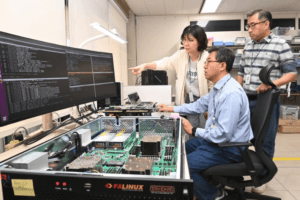South Korea is making a bold leap into the global supercomputing arena! With the groundbreaking development of the K-AB21 accelerator SoC, the nation is set to rival supercomputer giants like the U.S., China, Japan, and France. What was once a distant dream is now a reality thanks to the ETRI team of researchers. Their latest breakthrough is redefining the future of South Korea in the high-performance computing field.
What’s the Buzz About K-AB21?
Electronic and Telecommunication Research Institute (ETRI) announced the development of an accelerator system-on-chip (SoC) named K-AB21. This floating point accelerator chip speeds up supercomputers. Also, this remarkable achievement makes South Korea stand out in the global computing community. The basic appearance of K-AB21 gives a first impression of an ordinary chip. Do not underestimate the K-AB21 chip since it exceeds common silicon standards.
South Korea now developed its first domestically-made accelerator SoC system measuring 77mm x 67mm and is fabricated through the 12-nanometer manufacturing process. K-AB21 contains advanced technology that powers supercomputers and performs critical operations in climate modeling and scientific advancement.
The South Korean supercomputing sector has depended on foreign technology sources until this point. Through its K-AB21 project, the nation enters a new era that will grant it complete control of its technological capabilities. National pride plays no more significant role in this development than breaking South Korea’s dependence on foreign nations and developing their domestic expertise while accelerating innovation locally.
Here’s what makes K-AB21 a game-changer:
- The K-AB21 consists of 8 Teraflops (TFLOPS) Performance which computes 8 trillion calculations each second at an astonishing rate.
- 64-bit Parallel Computing Unit functions seamlessly with challenging calculations that need high precision levels.
- The device brings an incredible total of more than 4000 parallel floating-point operators along with it for its high-performance speed and precision capabilities.
- It includes Ultra High-Speed Interfaces such as DDR5 with PCIe GEN5 protocols.
- 3U size standard rack unit, it is about 5.25 inches high.
A Global Debut at SuperComputing24
ETRI displayed the K-AB21 supercomputer during the global SuperComputing24 event in Atlanta, USA the world’s biggest supercomputing technology exhibition in November 2019. Using real-time demonstrations ETRI gained both industry leaders’ and tech enthusiasts’ admiration of the chip’s capabilities in that event.
The upcoming milestones mark what will be the start of many successful developments. ETRI intends to start system-level verification testing of K-AB21-based high-performance computing servers during the first half of the next year. The commercialization of this technology will make South Korea the fifth nation worldwide capable of producing supercomputers.
Breaking the AI Barrier
The majority of universal accelerators currently operate best for artificial intelligence programs. The systems focus their capabilities on performing low-precision operations suitable for facial recognition capability and voice assistance functions while being inadequate for high-precision applications in scientific exploration and engineering simulations.

Enter K-AB21. The K-AB21 represents a special AI accelerator that stands apart from conventional NPUs (Neural Processing Units) or TPUs (Tensor Processing Units) because it was made to conduct double-precision floating-point (FP64) calculations. The processing system suits classic supercomputer operations because it delivers exceptional precision and computing strength to these applications.
The Team Behind the Tech
This achievement didn’t happen overnight. The product emerged from considerable years of committed research and development carried out by an organized team of researchers together with engineers. Under the guidance of the Ministry of Science and ICT and the National Research Foundation of Korea (NRF), the Supercomputer Computing Node Development based on the Massively Parallel Processor project received funding to move forward.
Key contributors include:
- ETRI takes charge as the leading institution that drives hardware advancements.
- Korea Institute of Science and Technology Information- Focused on software development.
- Ten university labs and two domestic enterprises: Collaborating on various aspects of R&D.
- The existing developments from the project include 29 patent applications together with 15 SCI papers and 3 technological transfers to industry.
Beyond Supercomputers: What’s Next for K-AB21?
The basic initiative centers on developing supercomputers yet K-AB21 shows great potential for numerous real-world applications. This breakthrough technology would transform businesses when it gets introduced to commercial markets.
The applications of K-AB21 showcase the following commercial opportunities:
- The next generation of cloud computing together with big data analytics receives its power from high-performance data centers.
- Self-driving vehicles require enhanced computational power to perform real-time decision-making capabilities.
- Intelligent Robots: Providing the brains behind smarter, more efficient machines.
- The Edge Servers alongside AI training mechanisms assist developers in deploying difficult AI models preferably near data collection points.
The upcoming R&D follow-up projects for South Korean high-performance computing indicate a promising future in this field.
ETRI Senior Vice President Il Yeon Cho of the Artificial Intelligence Computing Research Laboratory explained that “the valuable outcome originating from research work will serve to revitalize and establish the high-performance computing ecosystem in Korea”.
A Giant Leap for Korea
The victory brings advancement to South Korea while benefiting all members of the worldwide technological sector. South Korea demonstrates through K-AB21 that innovation transcends all limits through its development. The accomplishment demonstrates how teamwork combines with governmental backing and domestic engineering strength.
ETRI Research Fellow Woojong Han said that the latest breakthrough development of accelerator SoC will bolster technological autonomy in high-performance computing by competing against leading global big technology companies that monopolize the accelerator market.
The Future Is Here
K-AB21 represents a South Korean initiative that goes beyond competition by establishing itself as an innovative leader for future technology development.
The future of South Korean supercomputing can be observed through K-AB21 as it marks the start of an amazing journey for this technological advancement.

